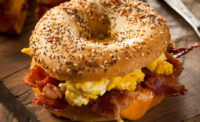Breakfast has several consumer needs to meet ranging from being appealing, delicious and nutritious to being quick and easy to eat.
“Breakfast is that meal that gets the most attention because consumers never have enough time in the morning and not everyone feels like eating in the morning,” says Lu Ann Williams, director of innovation at Innova Market Insights.
This makes convenience essential for breakfast. “Many Millennial consumers are used to eating out or having food delivered, so for them, even cereal isn’t fast enough,” Williams says. “But even for working moms and picky kids, convenience and great taste are very important.”
June Jo Lee, vice president of strategic insights at The Hartman Group, in Bellevue, Wash., finds breakfast to be like a snack occasion now. “If you think about snacks, they are portable,” she says. “They are easy to eat without utensils or a table, and so we’re seeing things move in that direction.”
Consumers do not typically use a lot of preparation time for breakfast either. Sixty-two percent of breakfasts across both weekday and weekends involve ready-to-eat products or no-preparation products, which highlights the need for convenience, says Chris Dubois, senior principal at Chicago-based Information Resources Inc. (IRI). This is double the percentage for dinner occasions.
In turn, more than three-quarters (77 percent) of packaging executives worldwide expect high or moderate demand for on-the-go-grocery products during the weekday mornings, while another 63 percent predict high or moderate demand during weekend mornings, according to a London-based Canadean’s Examining New Trends in the Breakfast Market and the Opportunities for Food Manufacturers report. While convenience and on-the-go demands are expected during weekday mornings, Canadean found the industry is preparing to take advantage of easier breakfasts for those who are time strapped on the weekends.
“Focusing purely on weekday breakfast convenience means brands risk leaving money on the table,” says Safwan Kotwal, an analyst at Canadean, in a statement. “While consumers’ timetables are arguably more flexible during the weekend, busier social lives are creating a new market for convenient, but at the same time indulgent, weekend breakfast products. Convenience purely targeted at busy office workers or busy parents on the school run means brands could be excluding themselves from a potentially very profitable weekend market.”
Brands built around convenience should consider brand extensions targeting weekend needs, Kotwal suggests. Companies building products around enjoyment and indulgence should consider diversifying their product portfolios to offer new, more convenient products that still provide something special for weekend consumers, he says.
Refreshing Breakfast
Consumers have several distinct differences from breakfast to dinner occasions. First, breakfast is routine while dinner is planned, IRI’s Dubois says. Breakfast is focused on individual meals, while dinner is one meal. Breakfast also is one at a time vs. together. In addition, breakfast is eaten for fuel, while dinner is focused on more.
IRI reports 80 percent of breakfasts are still prepared and consumed at home. Looking at sales, it’s not accurate to label any food products, particularly meat and poultry, to a specific meal occasion with traditional breakfast foods eaten at other meal occasions. Consumers do take in 20 percent of their meats at breakfast though, IRI reports.
Hartman’s Lee agrees consumers are not always thinking about breakfast-specific meat products just because they are branded as breakfast patties or breakfast sausages. “What we are seeing is a breakdown between the meal occasion definitions that the industry has long promoted,” she says. “Consumers are freely mixing and matching, so they are taking basic ingredients and reinventing breakfast.”
Consumer focus on protein-based foods continues to grow too, IRI says. In turn, the growth has been consistent across all protein groups, including bacon and sausage, the research firm says. And for frozen breakfast foods specifically, Mintel International, in Chicago, found in its Frozen Breakfast Foods, US report from July 2015 that high protein and high fiber are the most important attributes consumers look for when purchasing across the category (see “The demands placed on frozen breakfast foods” chart).
Following with consumer trends, several new breakfast launches that contain meat and poultry are extremely convenient. For example, Jimmy Dean Delights Frittatas: Turkey Sausage and Veggies and Cooked Perfect Breakfast Bites with scrambled egg, chorizo sausage and cheese in a breading are microwaveable products that can be held. Bagel Bites also expanded its brand with Breakfast Bacon, Sausage and Cheese.
“This is a great opportunity for meat and poultry ingredients in new forms for use in new formats like the muffin-shaped Jimmy Dean Frittatas or Cooked Perfect Breakfast Bites,” Innova’s Williams says. “These cross the line between snack format and breakfast ingredients and offer a great platform for meat.”
Breakfast sandwiches also remain popular with bread types ranging from the traditional English muffin and croissants to flatbread and waffles. For example, Kellogg’s offers Eggo Breakfast Sandwiches filled with ham, egg and cheese and Special K Flatbread Breakfast Sandwich with egg, bacon and cheese medley.
Lee also sees a lot of innovation around less processed, clean label and higher quality meat and poultry breakfast products, including terms such as hormone- and nitrate-free. In addition, coinciding with a decline in cereal sales, American breakfast has shifted from more sweet options to more savory.
“What we’re seeing is that consumers are seriously thinking about sugar and sugar content,” Lee says. “They are also thinking about good fats, and they are also thinking about incorporating vegetables.”
For food service operators, convenience continues to play a huge role as well. “We continue to see increased offers of both breakfast sandwiches and burritos and next-level, easier-to-travel foods like breakfast grain bowls,” says Joe Garber, marketing coordinator at Datassential, in Chicago.
High-protein offerings also satisfy demands for functionality, finds Technomic Inc.’s Breakfast Consumer Trend Report. Consumers want a breakfast that is filling, energizing and holds them over until lunch. In turn, high-protein items can help drive traffic by meeting demands for satiety, Technomic says.
Breakfast trends often come from casual dining restaurants, brunch menus or restaurants that specialize in doing brunch. “For meat, especially brewery restaurant brunches or places that place an emphasis on meat, but happen to do brunch, such as steakhouses or seafood restaurants, often do a very good job of highlighting the versatility of proteins,” Garber says.
The meats most commonly appearing on breakfast menus continue to be bacon, sausage and ham, with only bacon showing growth over the past year, Datassential reports. Chicken is found on more than 45 percent of breakfast menus at this point and is found on 4 percent more menus in 2015 than in 2014. Some meats that are experiencing rapid growth, but still found at only a few restaurants, include porchetta, pork belly, meatball and short ribs, Datassential says.
Consumers are more likely to purchase breakfast items that are low in fat, and chicken and turkey can be positioned as low-fat alternatives, Technomic reports. Operators increasingly are offering turkey as healthful breakfast options, and turkey bacon and turkey sausage are the two quickest growing proteins on Technomic’s Top 500 breakfast menus.
In turn, turkey sausage is the fast-growing protein in breakfast sandwiches for limited-service restaurants, Technomic reports. For example, Panera Bread and Tim Hortons have both offered turkey sausage since 2013, but other chains got rid of traditional turkey sandwiches in the same time period.
As far as innovation, a wide variety of dishes that have always included meat are diversifying the meats they are using as well.
“Before you might see only Canadian bacon on Eggs Benedict, but now there are interpretations that include short ribs or can include carnitas on a masa base,” Garber says. “This is also true of hash dishes with unique proteins. Sausage made from turkey or chicken are growing as well as bacon cuts and flavors.”
Ethnic influences, elevated comfort foods, Mediterranean and more vegetables are all continuing trends for the past several years in breakfast for foodservice.
“For ethnic influences, we are seeing flavors like sriracha, harissa and chimichurri all growing on breakfast menus,” Garber says. “As a result we are also seeing proteins related to these ingredients rising in menu penetration such as pork belly, merguez and grilled hanger steak. Elevated comfort food is another one where poultry especially is well positioned as chicken and waffles and chicken biscuits continue to gain traction at breakfast.”
Garber adds that increased use of vegetables can include very flavorful and indulgent meats as accent offerings because operators can afford to use these pricier cuts in smaller quantities and still maintain a reasonable profit margin.
Breakfast still remains part of the day where people are less comfortable trying new things, but a shift is occurring. “For meat to grow it will need to be proteins consumers are used to with interesting sauces or flavors or very unique proteins done in more familiar formats such as Eggs Benedict, breakfast sandwiches, breakfast burritos, etc.”
Limited-service restaurants also are promoting ethically raised proteins, such as gestation crate-free pork, which is a trend similar to full-service operations, Technomic reports.
At retail, the protein trend is still strong at breakfast as well, and meat and poultry have the added benefit of being a natural source of proteins that consumers definitely understand, Williams says. Consumers also are mindful that protein is tied to satiety, energy, performance and part of balanced nutrition, Hartman’s Lee says.
Meat and poultry breakfast products do have a plethora of competition to compete against for non-meat protein sources, though.
“The flexitarian/vegetarian trend is in full swing, and Europe is leading the way in innovation in terms of meat substitutes and alternatives,” Williams says. “But there are successful brands like Morning Star Farms in the U.S. We are seeing more exciting flavors in products like these, which make them appealing alternatives to meat.”
For processors, Williams says this competition is an opportunity to promote the credentials of animal welfare efforts, hormone-free or whatever the company is focused on. These products also can deliver a price premium.
Meat products also need to focus on less processed, higher quality, transparency and traceability, Hartman’s Lee says. “You see the rise of paleo as how does one eat better,” she says. “It’s eating compassionately and ground raised animals free from negatives. That’s the biggest thing we are going to continue to see.” NP








Report Abusive Comment